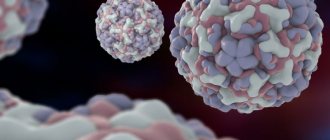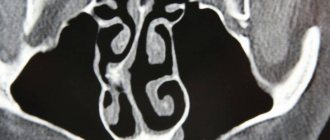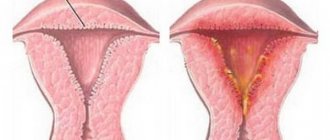About the disease
Chronic runny nose is an inflammatory process in the nasal cavity. Most often, the problem comes down to the fact that a regular runny nose has begun, which has not been fully treated. Exacerbation of rhinitis, along with inflammatory processes and infection, is provoked by the ingress of microbes.
The defense function, in other words, immunity, plays an important role for the functioning of the entire body. When these functions decrease, cell and tissue dysfunction occurs, which leads to a long-term cold.
Most often, school-age children and adults suffer from chronic runny nose . Rhinitis can appear due to improper treatment, deviated nasal septum, and problems with blood circulation.
According to the ICD, chronic rhinitis has code J31.0.
Signs of a chronic runny nose
According to medical experts, chronic runny nose can be diagnosed using the following characteristic clinical signs:
- Permanent appearance of mucous nasal discharge;
- Sneezing;
- Impaired olfactory function;
- Headache;
- Difficulty in nasal breathing;
- Sleep disorders;
- Possible itching and slight burning sensation in the nasal cavity.
Symptoms such as increased body temperature, muscle and joint pain with rhinitis occurring in a chronic form are usually absent. Clinical signs may differ slightly, depending on the form of the pathological process:
- With catarrhal rhinitis, nasal breathing becomes difficult and the sense of smell is impaired;
- With atrophic rhinitis, dry crusts form in the nasal cavity, with possible bloody impurities;
- With vasomotor rhinitis, attacks of sneezing, nasal congestion and the appearance of copious nasal mucous discharge are observed;
- With allergic rhinitis - sneezing, blockage of nasal breathing, clear nasal discharge of mucous consistency, lacrimation, soreness in the larynx, the appearance of rashes on the skin;
- Hypertrophic rhinitis is a permanent blockage of nasal breathing, a feeling of itching localized in the area of the nasal passages.
Root causes of the disease
The effectiveness of treatment for chronic runny nose is related to how well the provoking factor of the disease has been identified. A protracted inflammatory process in the nasal cavity may be a consequence of exposure to factors such as:
- Diseases of the heart and blood vessels.
- Crooked nasal septum.
- Presence of adenoids.
- Sinusitis.
- Sinusitis.
- Working conditions that are classified as harmful.
- Drinking alcoholic beverages. Smoking. Addiction.
In addition, among the provocateurs of chronic runny nose are:
- Infection of such types as: infectious, bacterial or fungal.
- Sinus diseases.
- Nose injury.
- Volatile toxins. Mercury vapor, sulfuric acid.
- External irritants: dust, smog, dry or cool air.
At-risk groups
The list of factors that put a person at risk of developing a chronic runny nose:
- Presence of the patient in areas where smoking is common. Direct smoking.
- Polluted atmospheric air.
- Working in a dry climate, such as a hot stove.
- Harmful factors of professional type.
- Sudden change in temperature.
- Diseases that reduce immunity.
- Congenital or acquired diseases that are associated with problems in the anatomy of the nasal bone.
- Treatment with sedative and hormonal drugs, use of oral contraceptives and drugs for the treatment of hypertension.
- Hereditary predisposition.
Possible complications
The consequences of chronic rhinitis, which are not treated promptly and efficiently, can be:
- Inflammatory processes in the ears.
- Caries formation.
- Eye problems, conjunctivitis.
- Pharyngitis.
- Bronchitis.
- Incorrect or neglected treatment of allergic rhinitis leads to the appearance of bronchial asthma.
Frequent breathing in cold air is fraught with inflammation of the tonsils, the appearance of a constant unpleasant odor from the mouth, and the presence of various diseases of the lungs and bronchi.
Types of chronic rhinitis
As we said above, there are several types of chronic rhinitis that are usually distinguished. Chronic rhinitis is classified according to the type of course and cause of occurrence.
Types of chronic rhinitis:
- Catarrhal. This type of chronic rhinitis occurs quite often and is characterized by problems in the respiratory process and high secretion of exudate;
- Allergic. This type of chronic rhinitis is perhaps the most common. It is provoked by irritation of allergens entering the respiratory tract through the nasal passage. It may appear due to the flowering of plants (in this case, seasonality is noted), or due to other factors (dust, animal hair, paint and other substances);
- Hypertrophic. It is characterized by hypertrophy of the mucous tissues of the nasal passage, the bone and periosteal structure of the nose, which as a result contributes to the formation of difficulties in nasal breathing;
- Vasomotor rhinitis. This type of pathology occurs against the background of an increase in the inferior nasal concha and abnormal activity of the nasal vessels in general. There is no inflammation as such;
- Atrophic. It is characterized by a decrease in density, as a result, the thickness of the mucous tissues of the nasal passage, the formation of specific crusts and the release of mucus from the nasal cavity;
We will also distinguish chronic posterior rhinitis as an independent type due to the specificity of the course of the disease - inflammation of the nasal passages and pharynx, the lymphatic structure in the location of the posterior wall of the nasopharynx.
Treatment
The optimal treatment method for a chronic type of disease is complex. It includes a number of therapy methods:
- Medication therapy.
- Physiotherapy procedures.
- Surgical operations.
- Using traditional medicine methods.
Based on the form of rhinitis, symptoms and treatment regimen may vary:
- During an exacerbation of rhinitis, magnetic laser therapy and homeopathy treatment have been widely used.
- In the atrophic form of the disease, medications are used whose action is aimed at improving the trophic qualities of the nasal membrane.
- Therapy for vasomotor disease includes laser treatment of chronic runny nose, cryodestruction, and microwave surgery.
- The catarrhal form is treated with local antibiotics. The drugs are prescribed by the doctor based on the results of the bacterial culture.
- The hypertrophic form is treated with surgical techniques using local anesthesia.
Drug therapy
Involves the use of sprays and drops to constrict blood vessels, balms and ointments with antiseptic and anti-inflammatory properties, and astringents. If an increase in temperature is observed, a fever reliever and antiviral medications are additionally prescribed.
When hard crusts appear in the nose, sprays and drops should have a softening effect.
Such preparations have an oil or salt base. The doctor prescribes antibacterial drugs if necessary.
Physiotherapy
Treatment of a runny nose using physiotherapy methods in adults is carried out using:
- Ultraviolet rays.
- Warming up.
- Foot baths.
- Inhalation of medications and aerosols with a special nebulizer (inhaler).
The duration of the course of therapy is about ten days. Prescribed by a doctor.
Surgery
In many cases, treatment for a prolonged runny nose ends with the doctor referring the patient to a surgeon who performs the operation:
Rhinitis: more about its types
Below you will find general information about the different types of chronic runny nose and its symptoms.
Catarrhal rhinitis is often caused by various infections (frequent acute respiratory infections). Chronic runny nose occurs due to the constant influence of gases, dust, and tobacco smoke on the nasal mucosa.
The prerequisites for the formation of this type of rhinitis are frequent pathologies of the pharynx and paranasal sinuses - for example, frontal sinusitis, chronic tonsillitis, sinusitis, adenoids, pharyngitis.
Symptoms of this type include: difficulty breathing through the nose in a lying position, periodic congestion of one or the other nasal passage, constant discharge from the nasal passages. The development of atrophic rhinitis leads to the atrophic process in the mucous membranes of the nose.
The exact causes of the disease have not been identified, but it can be said that frequent runny noses, injuries during surgical interventions on the nasal cavity, the influence of harmful substances on the mucous membrane, and constant inhalation of dry air can play a major role in the development of the pathology.
Symptoms include: dry nose, minor hemorrhages, and crust formation in the nasal passages.
As atrophy develops, the sense of smell may decrease. Hypertrophic rhinitis is a process in which there is an overgrowth of connective tissue in the nasal turbinates.
This type of runny nose can be provoked by constant irritation of the nasal mucosa, the presence of an infectious pathogen in the paranasal sinuses, adenoids, and frequent use of vasoconstrictor nasal drops. A deviated nasal septum can provoke the development of unilateral nasal enlargement.
Signs: impaired nasal breathing, which leads to decreased hearing, sense of smell and frequent headaches.
Ozena is a chronic pathology of the nose, in which there is a sharp change in the mucous membranes, the formation of secretions (they dry out and acquire an unpleasant odor), and thinning of the walls and bone tissues of the nose. Ozena is considered a fairly old disease, but there are no exact causes of its occurrence. Provoking factors include:
- Living in unsanitary conditions;
- Anatomical features of the structure of the nose;
- Anemia;
- Heredity.
Signs of ozena include an unpleasant odor in the nose, itching in the nasal passages, crusting, and difficulty breathing. When examined, patients with ozena are observed to have crusts in the nose covered with pus - it is this that emits an unpleasant odor. Such crusts are easily separated, but despite this, they provoke bone atrophy and enlargement of the nasal cavity.
Vasomotor rhinitis has two subtypes: neurovegetative and allergic rhinitis. Symptoms: attacks of sneezing, nasal discharge.
Prevention
Preventative treatment methods are important to follow. For rhinitis to transform into a chronic form, it is necessary:
- Timely treatment of all nasopharyngeal diseases under medical supervision.
- Avoid contact with allergens.
- Undergo procedures to correct structures of the nasal septum that were acquired at birth or as a result of injury.
- Avoid alcoholic beverages and nicotine.
- Your lifestyle should be healthy, start improving your immune system and hardening yourself.
Chronic rhinitis is an acute problem and poses a threat to human health. Neglected situations can lead to complex consequences, which can be eliminated forever only through surgical intervention.
It is important to protect yourself from the transformation of an acute runny nose into a chronic one. To do this, you must consult a doctor in a timely manner, do not engage in self-treatment and follow all preventive rules. A correct and responsible approach to therapy will allow you to avoid difficult situations and stay healthy.











